Eternal Sunshine of the Spotless Mind
Page 3 of 5
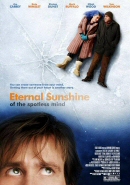
Several years ago, director Michel Gondry was having dinner with a friend, the artist Pierre Bismuth, in London. That night, Bismuth proposed a provocative idea: what if you received a card in the mail that stated you had been erased from someone’s memory, and that you should no longer attempt to contact them?
Around the same time, Gondry read Charlie Kaufman’s original screenplay for Being John Malkovich and sought to make a movie with the writer. Their work, whether it’s Gondry’s much-admired videos or Kaufman’s reality-bending screenplays, tends to turn convention inside out. “His writing inspires me,” says Gondry. “Soon, I had a completely different idea of how I should do this movie. It became about memories. How we are our memories, and how our memories affect our lives. Losing them – before you die – is tragic.”
“Michel came to me with this idea,” Kaufman remembers. “He asked me if I wanted to develop it into a screenplay and said, ‘Do you want to try to work on the pitch?’ I like Michel and I liked his videos.” To be titled Eternal Sunshine of the Spotless Mind (after a quotation from an Alexander Pope poem), the new work would combine romance, comedy, and emotion…

© Focus Features
…but first it had to be written, which “took me three years,” admits Kaufman, explaining that “I knew I had to do this other script first [Adaptation], and then when I finally got to this one, I was like, ‘I have no idea how to do it.’
“I think I have a logical mind, but I’m not a particularly organized person. My work tends to have symmetry, but if you saw my office…It’s not like I write from nine to twelve and then have a lunch. I do a lot of stalling.”
While Kaufman endeavored to begin work on the screenplay, Gondry meanwhile chose another of the writer’s original screenplays, Human Nature, for his feature directorial debut. “So I got to work with him and we got to know each other better,” says Kaufman. “It’s a constant dialogue between Charlie and me,” adds Gondry.
Producer Steve Golin (who had earlier produced Being John Malkovich) comments that “the two complement each other. Michel is truly gifted at visualizing. But he also has a lot of soul, which I think is sometimes lacking from people who come from a more visual background. But with Michel, there’s a lot of humanity. Charlie is probably the most imaginative writer that I’ve had the opportunity to work with. He creates characters and situations that are relatable but very unusual – and he also has very visual ideas.”
Producer Anthony Bregman (who had earlier produced Human Nature) adds, “Charlie’s screenplays are always surprising and intellectually rigorous, and also very emotional. Michel’s work is characterized by stories within stories, unfolding within each other – Chinese boxes of complication. This was a project that had very strong elements of both the writer and the director from the beginning, on every page. The thrill of working with both of them is their incredible imaginations.”
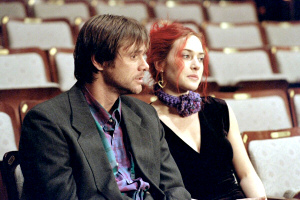
© Focus Features
Kaufman notes, “Our earliest, and our continual, conversations were about the level at which the camera might interfere with the personal reality. I’ve seen Michel’s videos, and there are some that show what it might be like in someone’s mind. We talked about imagery. I was thinking, ‘This is what Michel does, and it will be interesting what he does here.’ The imagery here is quiet, and a little bit fragile.”
Bregman notes that both Gondry and Kaufman “like to play with restrictions. They like to box themselves into parameters and then play within what they’ve boxed themselves into.” In Eternal Sunshine of the Spotless Mind, Kaufman and Gondry have created, explains Bregman, “a love story in reverse.”
When Lacuna’s memory-erasing process is initiated on Joel (Jim Carrey), the turbulent love affair he had with Clementine (Kate Winslet) begins to unfold – backwards. The first memories that replay are the most recent, and therefore the most volatile. However, as the more painful moments are washed away, the more tender and optimistic times together are revealed – and Joel falls in love with Clementine all over again.
While it may seem like a very unusual way to tell a love story, Kaufman explains that it came from the desire to depict something more realistic: “I think I always have in mind that I want to do something that reflects what I think is true, or at least is true in my life.” The screenwriter adds that most depictions of relationships on film “don’t have anything to do with my life. Maybe they have something to do with the life of people who make those movies, but not mine. This comes with warts and all, and I refuse to put a moral on it.”
Kaufman decided not to talk to Michel about the pending project “until I turned in the first draft. It’s like, you have to let me do it and then once you see it we can talk. Because it took me so long, because of the other things I had to do, it was very frustrating for Michel.
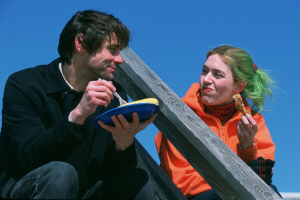
© Focus Features
“When I finished writing this, I was sort of aware that this was probably less of a comedy than anything I’ve written before.”
Bregman recalls that when he first read the finished script, “I sent Charlie an e-mail saying that I had finally read a love story which felt to me like the perfect telling of one, the love story I had always wanted to see. With warmth and emotion, it starts off at the point where two people are tired of each other. Then it moves backwards, telling how they got that way, to the beginning – that first blush of attraction. Then it wraps around itself and goes back to the end again, so that when these two characters get back into their relationship, they do it with the knowledge of what their relationship will become. That was the first time I had seen anything like that in a script.
“You see why people are attracted to each other, why people fall in love, why people fall out of love, why you get sucked into the mundaneness of a relationship after a long time. Some of this is hilarious, and some of it is painful; you see how frail and unstable relationships actually are.”
Golin states, “It’s a very honest movie in terms of what the difficulties in a relationship are. People will be able to relate to Joel and Clementine in this relationship – the good and the bad.”
Gondry’s take on the story extends well beyond relationships: “It’s about memories – how we are our memories, how our memories affect our life, and how losing memories is a tragedy.
“Each time one of the characters’ memory decays, it should reflect directly in the actors’ performances. So I needed actors who would be ready to be inventive – to surprise, and be surprised, on the set. To be flexible, and to adapt.”
A script that was both comedic and philosophical was bound to attract actors’, and industry, attention. By the time he finished the script, Charlie Kaufman had become an award-winning screenwriter, and the fact that the script had been in the works for so long only increased the curiosity and anticipation surrounding it. Steve Golin explains, “Frankly, a lot of people got hold of the script before we were ready to circulate it for casting. It was still being worked on and was an unofficial draft, in a sense. But the nature of Hollywood is that it’s hard to keep a secret, and the script got out.”
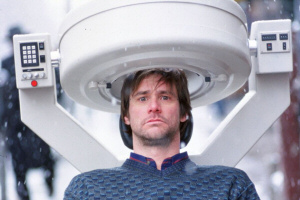
© Focus Features
Among those who read the script was Jim Carrey, who called the producers to say that he wanted to play Joel. Golin notes, “That was a good situation, because our search was done immediately.”
Of his sparking to the material, Carrey notes, “I was a tremendous fan of Charlie’s work and the screenplay hit a nerve in me, as I think it will in most people. Although it’s complex, it’s very relatable. I think it’s his best work so far.
“It’s one of those rare times where you are involved in something that makes you thankful for your painful experiences. I could not have played the part without living it.” To Gondry, the casting of a strong presence like Carrey was the perfect added ingredient to the project. He knew that “Jim would bring a lot to the character.”
Anthony Bregman adds, “I think that people are going to be very surprised to see the character that Jim is portraying here. Joel is very unlike any of the characters that Jim has played before. In many scenes, he is almost unrecognizable from the Jim Carrey that we all know.”
In fact, contends leading lady Kate Winslet, “I’m playing ‘the Jim Carrey part,’ and Jim’s playing ‘the Kate Winslet part’ – as far as what people may expect from either one of us as actors. Jim has done things with this character that no one’s ever seen him do before on-screen. Here, Jim plays the more restrained, controlled figure, while I play the totally chaotic figure who pulls silly faces. In this movie, everyone’s playing against type, which can only be a good thing.
“I’ve never really had a career agenda, as such. I do always look for something that’s going to be different and challenging. This is entirely different from anything I’ve ever done. The script was unbelievably clever and brilliant, and it had a heart to it as well. The simplicity of the central idea, about these two people very much in love, was important too.”
Golin reports, “Kate was passionate about doing it, and Michel wanted her right from the beginning.” Gondry adds, “We needed somebody very skilled, because Clementine is a very complex role, very well-written, very rich. When I met her, we connected.” The three-time Academy Award nominee threw herself into the role of Clementine: “It completely exhausted me, because she’s funny, larger than life, and eccentric.” But, ultimately, despite all the different hair colors and antic behavior, Winslet pegs Clementine as “sort of a vulnerable, shy person who’s really searching for her soul. She wants to figure out who she is. She’s slightly uncomfortable in her own skin. “She’s nothing like me, and yet in many ways she’s quite similar to me. I can occasionally be a foul-mouthed lunatic myself.”
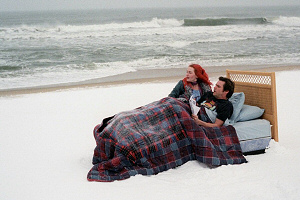
© Focus Features
Bregman confides that “Kate Winslet is very much Clementine. They’re both headstrong, passionate, and unpredictable – and completely loveable.”
Carrey comments, “Kate is someone to learn from. She is just so good at what she does, and so smart. And the best thing of all is she’s not as tough as she thinks.”
While Winslet acknowledges that at first people might think of her and Jim Carrey as “a really unlikely pairing, I think it makes it all the more intriguing. Jim likes to be surprised, and he likes to kind of improvise and play around – to find stuff that may or may not work. That was a great thing about working on this movie; we just played and played and played and played. Sometimes we got to the point where we were kind of crying with laughter. You know, I think they may even end up using some of it…We completely trusted Michel.”
The central love story is both shadowed by and at the mercy of another set of characters – the team erasing the leads’ memories. “What interested me about that section of the movie was the structural concept of playing with time,” reveals Kaufman. “This is all really happening in one night; these other characters are going through their own little stories that take place in one night, as opposed to Joel and Clementine’s story which takes place in two years. And yet these two different stories are happening simultaneously.”
These supporting roles were also magnets for talent. Golin states, “It’s a testament to the material.” The budget for the film was tight compared to those of the blockbuster films that several of the actors had starred in. Golin adds, “No one did this job for the money.” Mark Ruffalo’s take on the character of Stan, one of the Lacuna technicians, appealed to Gondry straight away: “Mark said that he would like to have a pompadour, and that’s why I cast him.”
Ruffalo comments, “I’d never read anything like this script. Then, after I saw Human Nature, I said, ‘I don’t care how small this part is, I want to be in this movie.’ Charlie Kaufman and Michel Gondry are a wonderful combination. Michel gets Charlie’s material; they fit. Charlie came to one of our rehearsals. He’s an incredible listener; he’s very inquisitive, he gets the thread of something and just keeps unraveling it.”
The actor saw his character as “a techno-geek who has real poetic ideas about what love is, but has not had much experience with it in his life. He doesn’t have much confidence in that particular arena. Stan is more like the guy who changes your oil than a professional who knows what he’s doing with this memory-erasing procedure. He’s just a hired guy.
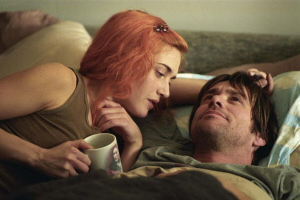
© Focus Features
“Michel has his own vision, his own take on things. He’ll place a lot in a wide shot, with people coming in, doing things, and then exiting the frame – with special effects right there on-set. You’re going, ‘How is that possible?’ But Michel does it.”
At their initial meeting, Elijah Wood surprised Gondry by expressing his familiarity with, and admiration for, the director’s and screenwriter’s oeuvres. “I’m a huge fan of both,” explains Wood. “This was a dream opportunity. I also felt quite lucky to be able to work with actors I admire.”
Initially, Gondry had been thinking of a different type of actor for the role of Patrick, “but Elijah ended up to be so perfect; he just made the character alive.”
For his part, the actor had been looking for a different type of role from his globally popular Frodo Baggins in The Lord of the Rings films. “A lot of people judge Patrick pretty quickly, as a devious character. But he’s not a bad guy; he can’t really get women in any normal way, so he has to use somebody else’s knowledge.
“There was a real live energy on the set. The first couple of days, the camera would roll and we wouldn’t necessarily know it. Michel wanted to create real moments, so there was a free-form element to the way that things were shot.”
One facet that Gondry found was chemistry, which he stoked, between Wood and Ruffalo. Gondry reports, “The relationship was like big brother/little brother. They are just great to watch. The main storyline can get very emotional and intense, while these two guys are having a really good time.”
Ruffalo adds, “You see Stan and Patrick fumbling and bumbling around, banging their equipment together, and getting chips and Cokes and stuff all over medical equipment…Elijah and I had a really good time.”
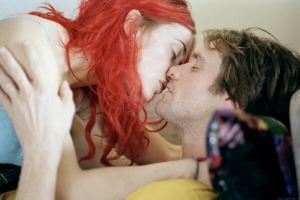
© Focus Features
Kaufman elaborates on the contrast between the barely professional behavior of the Lacuna employees and the personal drama that is simultaneously unfolding: “The idea was, this is their job. I think this true of anybody who works in service or retail – the customer, who is really who you work for, is your enemy. You talk trash about them.
You hate them. It’s just a very weird relationship that you have with these people that you’re supposed to be serving – in this case, someone who’s unconscious. You go inside Joel, and see the absolute trauma that he’s going through, and then you go back outside and they’re doing what they’re doing and paying him no mind; I thought it was a good and funny contrast.
“At the same time, it’s also kind of tragic. Because it shows that it’s very hard to get people to step out of their own lives and care about other people. Their own dramas are where their focus is.”
Rounding out the “support staff” that literally surrounds Joel is Kirsten Dunst as Mary, the Lacuna secretary (and Mierzwiak acolyte) who makes a fateful decision to observe Joel’s process firsthand. The actress was among those who had gotten hold of the script well before the movie got made. “I read it in 2001,” reports Dunst. “It was so intriguing. Charlie creates such amazing characters. I buzzed through it and said ‘I want to do this movie.’
“My favorite film of a Charlie Kaufman script was the movie that Michel did, Human Nature. So I was a big fan of both of them. I think Michel thought I was too young at first. Two years later, it finally came to fruition, so then I got to be in the movie.” Gondry says that he was surprised by the maturity that Dunst brought to the role. “My main concern was that she seems to have no worries. But she’s very intellectual, and when I told her, ‘Listen, you need to be a little darker than usual,’ she was great at that.” Dunst found the director to be “really funny, with a great eye and very good intuition. He knows the whole spectrum, from visuals to emotions.
“There were no egos on the set. We moved at a fast pace, which I loved. We’d get the scene going and everybody’s coverage was done at the same time. We’d do take after take after take, consecutively. Coming off of big-budget films where one setup takes five hours, it was so refreshing to be in a movie like this; it’s good for the acting and it keeps you in the moment.”
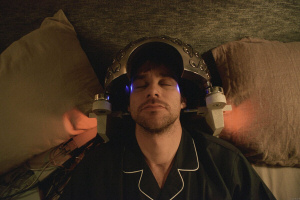
© Focus Features
Oscar-nominated actor Tom Wilkinson had admired Being John Malkovich, and found the new Charlie Kaufman screenplay to be “wonderfully well-written, tremendously intelligent, and very witty and touching. I was very enthusiastic to be in this movie.
“It was a revelation to meet and work with Jim Carrey, and this is a cast of very talented actors.”
Landing Wilkinson for the role of Lacuna chief Dr. Mierzwiak was a coup, says Bregman: “He brings this incredible gravity and seriousness to the memory-erasure operation, which to some may seem a little too sci-fi. But to hear Tom Wilkinson tell you about it, it’s entirely believable and authoritative.”
Echoing his colleagues’ assessments of the director’s shooting pace and style, Wilkinson found that “Michel is unlike any other director I’ve worked with. He has a rather unorthodox approach, but you give him the benefit of the doubt because you know what he’s doing is going to be exciting. You’re not overburdened with rehearsal – and you’re never quite sure where the camera is going to be. Very often, he lets the camera roll the very first time you are doing the scene. Which I liked, because very often, in my own experience, I’ve found my best stuff is often done in rehearsals. And I’d think, ‘Oh, why wasn’t the camera turning?’
“Michel lets the cameras run so you can do two or three takes without having to stop. That was slightly unnerving at first, because you don’t quite know how far you’re going to go in a given scene. Very often we kept going until the camera ran out of film. But if you wanted to let loose, you could; he was very free about it. If you wanted do it again, if you had a different idea for doing something, Michel would accommodate that. So he was a dream to work with.”
Golin muses, “What still interests me about this business is the different ways directors approach the creative process. Michel is a lot looser in the way that he directs. A lot of the time, the evolution of his ideas takes place on the set. Some filmmakers can be very rigid, with everything completely thought out – they don’t particularly want a lot of invention or adaptation on the set. While Michel has a general idea of what he’s doing when he gets to the set, he likes to see the idea evolve and likes to give the actors a lot of freedom. He will then expand or contract the idea to suit his needs.”
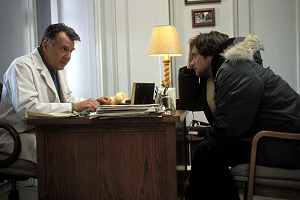
© Focus Features
The conception of memories being erased inspired many potent visuals. Bregman feels that “Michel’s method works really well in terms of reproducing what goes on in your mind, because memory works also in a non-linear way. Memory is constructed from little bobs, items, and impressions. Here, scenes and characters are kind of combined, in an Impressionistic way. Since this is a movie about memory, the intuitive way in which things and events from your past are connected materializes within the scenes.”
Bregman elaborates, “Michel’s mind works in a very unusual way, one which utilizes a portion of the brain which I think is inaccessible to most of us. I think when Michel constructs shots, he constructs them first from the script, then considers what he can do to wrap the script around visual concepts and also wrap visual concepts around the script. If you see him during lunch, staring at a spoon, it’s probably because he’s figuring out how to refract light and image for a shot later on in the afternoon.”
Production designer Dan Leigh adds, “Directors need to be visual, but Michel is hypervisual. He’s always got a camera with him. At dinner one night, he was picking up the orange slice from someone’s drink and putting it in front of the flash, and also shooting pictures of his girlfriend through a bottle.”
Props aside, the mere telling of the love story evolving before, during, and after eroding memories posed a creative challenge. Gondry wanted to make the movie “as real as possible. Even if a story is complete science-fiction, it should be believable,” the director states.
Gondry’s first feature as director, Human Nature, was a fable of sorts, made with artificial-looking sets and controlled environments. For Eternal Sunshine of the Spotless Mind, Gondry embarked on the completely opposite approach. He wanted to “never have a preconceived notion of how it should be and look, and be open to possibilities.”
Ultimately, Eternal Sunshine of the Spotless Mind was made using few special or artificial techniques, and was filmed in a near-documentary style. Gondry decided that there would be “raw effects; low-key, but still spectacular.” The more organic or handmade approach would include in-camera tricks of the eye and on-set sleight-of-hand.
Gondry was comfortable with this method, having used it throughout his career. When he first became interested in filmmaking, he had bought himself a 16-millimeter camera to film his subjects. He remembers, “I would not do something if I could not figure how to do it by myself, or I could not find the solution by myself.” From this self-taught background, he developed the caveat “always use invention to solve a problem,” which was the operating principle on the new film. And, where better to shoot than in New York City, the location which always encourages filmmakers to think on their feet? “A great place to shoot,” declares Gondry. “There’s always energy.”
The NYC locale was decided on early in the creative process, “to try to make it feel as real and gritty as possible,” says Bregman. Golin adds, “It’s a look and a feel we wouldn’t have gotten had we shot someplace else. You get a tremendous production value – without doing much – that you don’t get in L.A. or in any other city. We also made an effort to hire people who were based in New York.” Among the latter was one of independent cinema’s most respected cinematographers, Ellen Kuras.
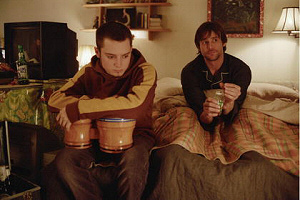
© Focus Features
Although a lot of the film is not necessarily set in NYC proper, but rather in surrounding areas, the energy and feel of the city were identified as assets to the shoot. Key scenes were filmed in such locations as Manhattan’s Grand Street on the Lower East Side (site of the Lacuna Inc. offices), Yonkers (for Joel’s apartment), Williamsburg (for Clementine’s apartment), and Grand Central Station (as itself). The cast and crew also spent a week in Montauk, Long Island to shoot the Montauk and beach sequences.
The shoot began on January 13th, 2003, and wrapped on April 3rd. Golin remembers, “It was a big challenge: we were outside a lot at night during one of the coldest winters on record in the greatest city on Earth.”
But Gondry found the adverse conditions to be felicitous, noting, “The script called for a lot of snow. When we did the location scouting, we realized that fake snow would cost too much money and would look contrived. So we wrote the snow out of the script – Charlie crossed out the snow mentions. But, quite amazingly, once we started to shoot, it snowed and snowed. We used that to our advantage.” One benefit was shooting on an actual frozen lake in upstate New York, for the Charles River scenes.
Gondry enthusiastically adds, “Every time the actors were outside speaking, there was steam coming out of their mouths, which helps makes the film very vivid and real.” Instead of the production imposing its own look or style upon the real-life locations, the real led the “reel.” In pre-production, Gondry, Leigh, and crew members visited various locations on a typical day. From a beach in Montauk to an estate in Wainscott to a bar in Brooklyn to Madison Square Park to the 125th Street subway station, the distinctly New York locales were documented on video. Those videos influenced how the scenes would eventually be shot, what the extras would look like, and how they would be dressed by costume designer Melissa Toth and her team.
Even for the memory-erasing headgear, an item that could easily have been crafted outlandishly, realism was the guiding inspiration. Leigh and Gondry met with a neurosurgeon at Manhattan’s Mount Sinai Hospital to glean ideas about how to design the helmet. They found their inspiration in a piece of equipment used by neurosurgeons as a brain-scanning device for difficult brain tumors. Photos of the helmetlike device were given to the art department, with follow-up research on the internet also incorporated into small models that were prepared for Gondry. The final full-scale model incorporated different ideas yet is still based primarily on the true-life piece of equipment.
Kaufman adds, “Michel allowed stuff to happen in a very organic way. What I like about Michel is that he’s got this technical brilliance, and yet there’s this human stuff going on. That’s a really unusual combination.”
Everyone became conscious of not wanting to upstage the story with the visual elements. There was initial discussion over whether Lacuna’s headquarters should have a slick, high-tech look. But, Leigh notes, “Michel was the first one to say ‘No, I don’t want that.’ He wanted it to seem like not mainstream medicine, not highly funded – kind of a fringe therapy. A downplayed presentation. By making even the office equipment familiar, it makes the audience comfortable – so that when you start getting into the unreal stuff, it’s more accessible.”
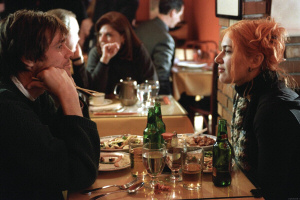
© Focus Features
“This means you’re following the story and the characters; you’re not distracted by a weird piece of equipment. I remember from my first meeting with Michel, he said that you should never lose track that this is a movie about the relationship of these two people. And he held fast to that.”
At that same initial meeting, the production designer recalls, “Michel asked me how I liked to work. I said that the most important thing to me was what the actors were doing; I don’t really care about giant architecture and making all of that. I make sure that everything I’m doing is supporting and enhancing the characters, and helping the actors do their job. Because movies are about people.
“Michel wanted this movie to be very real, to feel very real – even when you were in memory. That was critical to him. The more real the movie felt, the more successful the memory part would feel.”
The layering of scenes that would be required to depict the maze of Joel’s memories required the conception and creation of unusual transitions. Leigh remembers, “We’d meet for hours with Michel as he described the transitions that he had in mind. Many of these were not on the page and were hard to budget or even approach – and were on real locations.”
Budget restraints only enhanced the creativity, says Leigh: “Things became simpler and a lot more wonderful. We were going back to really early devices of filmmaking, and particularly French filmmaking, as opposed to the digital way. Michel knows about a lot of early techniques that we don’t know about, or that have been almost forgotten.” “For instance, the kitchen table scene is one that people will think was really complicated. In fact, it’s a visual trick that came out of the Renaissance. Museums sometimes do installations like that. It’s a distortion chamber, and design to shooting happened in five days.”
Winslet says, “I’ve never seen anything like what Michel does, just by twisting a light or putting in panes of glass. I’m present in a frame, and then I disappear in front of your very eyes. It’s like magic.”
Leigh explains, “Michel has a true understanding of light and camera; he has an intimate relationship with those kind of ideas. That’s how he’s so knowledgeable and he’s able to do tricks with them.”
Leigh also knew some tricks of his own, as he explains: “I have a theater background and a degree in stage design. So I know stage techniques that are illusionary; several years ago, I did some design work for two magicians. In working for them, I learned about illusion.”
This low-tech, high creativity approach was also great fun for the actors. Titanic veteran Kate Winslet says, “Ordinarily, digital effects happen way later, and they end up costing studios a lot of money. Michel would take a few bits of paper, make things resembling 13 origami, and plunk them onto the camera, and produce the most extraordinary effects. It was great to observe that and to be a part of it.”
Winslet also got involved early on with her character’s look and milieu. She explains, “So much of this character is in how she looks. There was only so much preparing I could do, because I knew that I could never entirely be her until the wigs, gloves, and rings were on. Melissa Toth and I discovered what she looked like. It was about finding a balance; the obvious thing would have been to make her look completely insane, but then it wouldn’t have been real.”
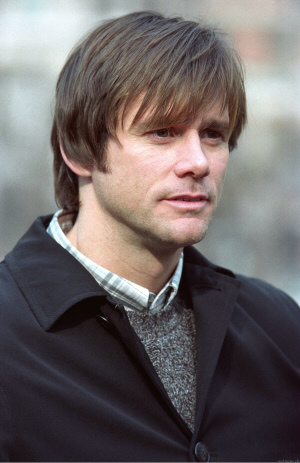
© Focus Features
Additionally, Leigh remembers, “I spent quite a bit of time, early in pre-production, with Kate, talking to her about Clementine. It was part of her process of figuring out the character. A week before we shot Clementine’s apartment, Kate came to see it by herself. Then my department went in and she had a couple of suggestions. Right away, she felt at home in the apartment – she sculpted a small aluminum foil chalice and put that on a shelf, and went around doing little things like that. Clementine changes her hair color all the time and clearly she’s somebody who can’t commit, so – subliminally – her apartment was painted 10 different colors. Not many directors would have allowed such a thing, but Michel gave me a long leash. When Kate saw it, she was like, ‘Yeah!’” “Joel’s apartment is one color (off-white), kind of neat, and a little bland. It’s kind of nowhere, like Joel probably thinks of himself. Early on, Jim made a couple of suggestions of things that he would like to have in there. He wanted a Groucho Marx presence [which became manifest, in the form of a 1970s-issue ventriloquist’s dummy incarnation of the great comedian] and artwork of an asteroid racing towards the earth – and that was about it. He didn’t come into the apartment until the day before we shot there. He walked around, was very complimentary, sat down at the kitchen table, ordered takeout food, and ate the meal there. He made himself feel at home. He also did some of the sketches in Joel’s journal, and they were quite good.”
Carrey remembers, “We were heavily into detail. I was sketching a lot in Joel’s books, jotting down Joel’s thoughts – or maybe they were my thoughts. Paul Proch did a lot of the drawings in the house and in the movie. I rubbed up against a couple of things and spread my pheromones all around, which made it very realistic.”
While the actor came to more fully inhabit Joel’s apartment, Leigh clarifies that “the real apartment was in Yonkers, and we had to duplicate it into a set for practical reasons – including greater accessibility for the camera and more time for Michel to work with the actors. He would imagine the transitions – things not on the page – but I’d find that when we actually got to it, the image that he had was abstract. So he didn’t know what the camera angles were going to be, or exactly how we were going to shoot it. That was figured out on the spot, and we had to do what we could to make it happen for him. “What he did know was how it would be cut together later. He knew how the editing process would work so that the elements he needed would blend together the way he needed them to get the transitions to flow. He knew exactly how he was going to use them.” To that end, Gondry worked closely with film editor Valdís Óskarsdóttir, who, as a veteran of the experimental Dogme filming method, was ready for any and all of Gondry’s creative assemblages.
The physical disappearance of Joel’s tangible memories, always in the script, was handled quite practically, often by removing set dressing and paring down rooms. Leigh explains, “It had to be noticeable when things would disappear. The problem was, there was no way for Michel to ever tell you ahead of time what he possibly wanted to take away. So I always had to make sure that when a set was empty that it would still have a little bit of visual interest to it, so you’re still left with something of the character [who lives there], even when it’s stripped away.”
Gondry found one source of visual inspiration from film itself. As Leigh explains, “I don’t think Michel ever used another film as reference. But we – Ellen Kuras, Michel, and myself – sat and watched film that had been stored improperly so that the images had been degraded. We were talking about ways for the memories to degrade.”
“Michel is a visual genius,” declares Winslet, adding, “He’s both mysterious and thorough at the same time. The directors I’ve worked with in the past have been one or the other of those things. He’s very much a combination of the two.
“By the end of the shoot, I literally did not look at the call sheet for each day, because I knew that Michel would have dreamt up something and would communicate it to everyone when we arrived at work in the morning. We’d had a thorough rehearsal process, so we knew who the characters were and where they were, or needed to go, emotionally. And then Michel would come up with visual stuff. It was exciting, and fun.” Gondry’s spontaneity was well-suited to the naturalistic feel that he sought for Eternal Sunshine of the Spotless Mind, says Golin. The producer admits, “We had a tight budget and a tight schedule. Sometimes when Michel came up with an idea on the day of shooting, there was a bit of a scramble. We were all on our toes, because we realized that things could change at a moment’s notice. But that different atmosphere was conducive to what Michel was trying to attain creatively. Our job really was to give Michel the ability to achieve what he wanted.”
Leigh concurs, stating, “I find that way of working to be energizing and I’d do it again in a second. Usually a movie is planned in such a specific way that you rarely have the elasticity that was here.”
Gondry reflects, “The crew was very responsive to my last-minute suggestions. It’s difficult to do in the middle of a movie, but everybody understood that we wanted to be spontaneous. I tried not to be too much of a control-freak, and to let accidents happen. “We started with some scenes that were clearly impossible, and then little by little we ended up doing something we never imagined we could do.” 15 So, whether it was freezing temperatures and snow, indoor rain on a set, or actors disappearing through false doors, the cast and crew were ready for anything. Including the kitchen sink – in which Jim Carrey and Kate Winslet took a bath.
The only thing that could top that was to join the circus. One afternoon on the set in Manhattan, someone noticed that the famed Ringling Bros. and Barnum & Bailey circus was in town and was going to have its annual midnight Elephant Walk parade across 34th Street that very night. A few hours later, cast and crew were on the scene and Joel and Clementine were at the parade.
Shooting Eternal Sunshine of the Spotless Mind had both the precision and the spontaneity of a circus, and everyone enjoyed the ride.
“Michel came to me with this idea,” Kaufman remembers. “He asked me if I wanted to develop it into a screenplay and said, ‘Do you want to try to work on the pitch?’ I like Michel and I liked his videos.” To be titled Eternal Sunshine of the Spotless Mind (after a quotation from an Alexander Pope poem), the new work would combine romance, comedy, and emotion…

© Focus Features
…but first it had to be written, which “took me three years,” admits Kaufman, explaining that “I knew I had to do this other script first [Adaptation], and then when I finally got to this one, I was like, ‘I have no idea how to do it.’
“I think I have a logical mind, but I’m not a particularly organized person. My work tends to have symmetry, but if you saw my office…It’s not like I write from nine to twelve and then have a lunch. I do a lot of stalling.”
While Kaufman endeavored to begin work on the screenplay, Gondry meanwhile chose another of the writer’s original screenplays, Human Nature, for his feature directorial debut. “So I got to work with him and we got to know each other better,” says Kaufman. “It’s a constant dialogue between Charlie and me,” adds Gondry.
Producer Steve Golin (who had earlier produced Being John Malkovich) comments that “the two complement each other. Michel is truly gifted at visualizing. But he also has a lot of soul, which I think is sometimes lacking from people who come from a more visual background. But with Michel, there’s a lot of humanity. Charlie is probably the most imaginative writer that I’ve had the opportunity to work with. He creates characters and situations that are relatable but very unusual – and he also has very visual ideas.”
Producer Anthony Bregman (who had earlier produced Human Nature) adds, “Charlie’s screenplays are always surprising and intellectually rigorous, and also very emotional. Michel’s work is characterized by stories within stories, unfolding within each other – Chinese boxes of complication. This was a project that had very strong elements of both the writer and the director from the beginning, on every page. The thrill of working with both of them is their incredible imaginations.”

© Focus Features
Kaufman notes, “Our earliest, and our continual, conversations were about the level at which the camera might interfere with the personal reality. I’ve seen Michel’s videos, and there are some that show what it might be like in someone’s mind. We talked about imagery. I was thinking, ‘This is what Michel does, and it will be interesting what he does here.’ The imagery here is quiet, and a little bit fragile.”
Bregman notes that both Gondry and Kaufman “like to play with restrictions. They like to box themselves into parameters and then play within what they’ve boxed themselves into.” In Eternal Sunshine of the Spotless Mind, Kaufman and Gondry have created, explains Bregman, “a love story in reverse.”
When Lacuna’s memory-erasing process is initiated on Joel (Jim Carrey), the turbulent love affair he had with Clementine (Kate Winslet) begins to unfold – backwards. The first memories that replay are the most recent, and therefore the most volatile. However, as the more painful moments are washed away, the more tender and optimistic times together are revealed – and Joel falls in love with Clementine all over again.
While it may seem like a very unusual way to tell a love story, Kaufman explains that it came from the desire to depict something more realistic: “I think I always have in mind that I want to do something that reflects what I think is true, or at least is true in my life.” The screenwriter adds that most depictions of relationships on film “don’t have anything to do with my life. Maybe they have something to do with the life of people who make those movies, but not mine. This comes with warts and all, and I refuse to put a moral on it.”
Kaufman decided not to talk to Michel about the pending project “until I turned in the first draft. It’s like, you have to let me do it and then once you see it we can talk. Because it took me so long, because of the other things I had to do, it was very frustrating for Michel.

© Focus Features
“When I finished writing this, I was sort of aware that this was probably less of a comedy than anything I’ve written before.”
Bregman recalls that when he first read the finished script, “I sent Charlie an e-mail saying that I had finally read a love story which felt to me like the perfect telling of one, the love story I had always wanted to see. With warmth and emotion, it starts off at the point where two people are tired of each other. Then it moves backwards, telling how they got that way, to the beginning – that first blush of attraction. Then it wraps around itself and goes back to the end again, so that when these two characters get back into their relationship, they do it with the knowledge of what their relationship will become. That was the first time I had seen anything like that in a script.
“You see why people are attracted to each other, why people fall in love, why people fall out of love, why you get sucked into the mundaneness of a relationship after a long time. Some of this is hilarious, and some of it is painful; you see how frail and unstable relationships actually are.”
Golin states, “It’s a very honest movie in terms of what the difficulties in a relationship are. People will be able to relate to Joel and Clementine in this relationship – the good and the bad.”
Gondry’s take on the story extends well beyond relationships: “It’s about memories – how we are our memories, how our memories affect our life, and how losing memories is a tragedy.
“Each time one of the characters’ memory decays, it should reflect directly in the actors’ performances. So I needed actors who would be ready to be inventive – to surprise, and be surprised, on the set. To be flexible, and to adapt.”
A script that was both comedic and philosophical was bound to attract actors’, and industry, attention. By the time he finished the script, Charlie Kaufman had become an award-winning screenwriter, and the fact that the script had been in the works for so long only increased the curiosity and anticipation surrounding it. Steve Golin explains, “Frankly, a lot of people got hold of the script before we were ready to circulate it for casting. It was still being worked on and was an unofficial draft, in a sense. But the nature of Hollywood is that it’s hard to keep a secret, and the script got out.”

© Focus Features
Among those who read the script was Jim Carrey, who called the producers to say that he wanted to play Joel. Golin notes, “That was a good situation, because our search was done immediately.”
Of his sparking to the material, Carrey notes, “I was a tremendous fan of Charlie’s work and the screenplay hit a nerve in me, as I think it will in most people. Although it’s complex, it’s very relatable. I think it’s his best work so far.
“It’s one of those rare times where you are involved in something that makes you thankful for your painful experiences. I could not have played the part without living it.” To Gondry, the casting of a strong presence like Carrey was the perfect added ingredient to the project. He knew that “Jim would bring a lot to the character.”
Anthony Bregman adds, “I think that people are going to be very surprised to see the character that Jim is portraying here. Joel is very unlike any of the characters that Jim has played before. In many scenes, he is almost unrecognizable from the Jim Carrey that we all know.”
In fact, contends leading lady Kate Winslet, “I’m playing ‘the Jim Carrey part,’ and Jim’s playing ‘the Kate Winslet part’ – as far as what people may expect from either one of us as actors. Jim has done things with this character that no one’s ever seen him do before on-screen. Here, Jim plays the more restrained, controlled figure, while I play the totally chaotic figure who pulls silly faces. In this movie, everyone’s playing against type, which can only be a good thing.
“I’ve never really had a career agenda, as such. I do always look for something that’s going to be different and challenging. This is entirely different from anything I’ve ever done. The script was unbelievably clever and brilliant, and it had a heart to it as well. The simplicity of the central idea, about these two people very much in love, was important too.”
Golin reports, “Kate was passionate about doing it, and Michel wanted her right from the beginning.” Gondry adds, “We needed somebody very skilled, because Clementine is a very complex role, very well-written, very rich. When I met her, we connected.” The three-time Academy Award nominee threw herself into the role of Clementine: “It completely exhausted me, because she’s funny, larger than life, and eccentric.” But, ultimately, despite all the different hair colors and antic behavior, Winslet pegs Clementine as “sort of a vulnerable, shy person who’s really searching for her soul. She wants to figure out who she is. She’s slightly uncomfortable in her own skin. “She’s nothing like me, and yet in many ways she’s quite similar to me. I can occasionally be a foul-mouthed lunatic myself.”

© Focus Features
Bregman confides that “Kate Winslet is very much Clementine. They’re both headstrong, passionate, and unpredictable – and completely loveable.”
Carrey comments, “Kate is someone to learn from. She is just so good at what she does, and so smart. And the best thing of all is she’s not as tough as she thinks.”
While Winslet acknowledges that at first people might think of her and Jim Carrey as “a really unlikely pairing, I think it makes it all the more intriguing. Jim likes to be surprised, and he likes to kind of improvise and play around – to find stuff that may or may not work. That was a great thing about working on this movie; we just played and played and played and played. Sometimes we got to the point where we were kind of crying with laughter. You know, I think they may even end up using some of it…We completely trusted Michel.”
The central love story is both shadowed by and at the mercy of another set of characters – the team erasing the leads’ memories. “What interested me about that section of the movie was the structural concept of playing with time,” reveals Kaufman. “This is all really happening in one night; these other characters are going through their own little stories that take place in one night, as opposed to Joel and Clementine’s story which takes place in two years. And yet these two different stories are happening simultaneously.”
These supporting roles were also magnets for talent. Golin states, “It’s a testament to the material.” The budget for the film was tight compared to those of the blockbuster films that several of the actors had starred in. Golin adds, “No one did this job for the money.” Mark Ruffalo’s take on the character of Stan, one of the Lacuna technicians, appealed to Gondry straight away: “Mark said that he would like to have a pompadour, and that’s why I cast him.”
Ruffalo comments, “I’d never read anything like this script. Then, after I saw Human Nature, I said, ‘I don’t care how small this part is, I want to be in this movie.’ Charlie Kaufman and Michel Gondry are a wonderful combination. Michel gets Charlie’s material; they fit. Charlie came to one of our rehearsals. He’s an incredible listener; he’s very inquisitive, he gets the thread of something and just keeps unraveling it.”
The actor saw his character as “a techno-geek who has real poetic ideas about what love is, but has not had much experience with it in his life. He doesn’t have much confidence in that particular arena. Stan is more like the guy who changes your oil than a professional who knows what he’s doing with this memory-erasing procedure. He’s just a hired guy.

© Focus Features
“Michel has his own vision, his own take on things. He’ll place a lot in a wide shot, with people coming in, doing things, and then exiting the frame – with special effects right there on-set. You’re going, ‘How is that possible?’ But Michel does it.”
At their initial meeting, Elijah Wood surprised Gondry by expressing his familiarity with, and admiration for, the director’s and screenwriter’s oeuvres. “I’m a huge fan of both,” explains Wood. “This was a dream opportunity. I also felt quite lucky to be able to work with actors I admire.”
Initially, Gondry had been thinking of a different type of actor for the role of Patrick, “but Elijah ended up to be so perfect; he just made the character alive.”
For his part, the actor had been looking for a different type of role from his globally popular Frodo Baggins in The Lord of the Rings films. “A lot of people judge Patrick pretty quickly, as a devious character. But he’s not a bad guy; he can’t really get women in any normal way, so he has to use somebody else’s knowledge.
“There was a real live energy on the set. The first couple of days, the camera would roll and we wouldn’t necessarily know it. Michel wanted to create real moments, so there was a free-form element to the way that things were shot.”
One facet that Gondry found was chemistry, which he stoked, between Wood and Ruffalo. Gondry reports, “The relationship was like big brother/little brother. They are just great to watch. The main storyline can get very emotional and intense, while these two guys are having a really good time.”
Ruffalo adds, “You see Stan and Patrick fumbling and bumbling around, banging their equipment together, and getting chips and Cokes and stuff all over medical equipment…Elijah and I had a really good time.”

© Focus Features
Kaufman elaborates on the contrast between the barely professional behavior of the Lacuna employees and the personal drama that is simultaneously unfolding: “The idea was, this is their job. I think this true of anybody who works in service or retail – the customer, who is really who you work for, is your enemy. You talk trash about them.
You hate them. It’s just a very weird relationship that you have with these people that you’re supposed to be serving – in this case, someone who’s unconscious. You go inside Joel, and see the absolute trauma that he’s going through, and then you go back outside and they’re doing what they’re doing and paying him no mind; I thought it was a good and funny contrast.
“At the same time, it’s also kind of tragic. Because it shows that it’s very hard to get people to step out of their own lives and care about other people. Their own dramas are where their focus is.”
Rounding out the “support staff” that literally surrounds Joel is Kirsten Dunst as Mary, the Lacuna secretary (and Mierzwiak acolyte) who makes a fateful decision to observe Joel’s process firsthand. The actress was among those who had gotten hold of the script well before the movie got made. “I read it in 2001,” reports Dunst. “It was so intriguing. Charlie creates such amazing characters. I buzzed through it and said ‘I want to do this movie.’
“My favorite film of a Charlie Kaufman script was the movie that Michel did, Human Nature. So I was a big fan of both of them. I think Michel thought I was too young at first. Two years later, it finally came to fruition, so then I got to be in the movie.” Gondry says that he was surprised by the maturity that Dunst brought to the role. “My main concern was that she seems to have no worries. But she’s very intellectual, and when I told her, ‘Listen, you need to be a little darker than usual,’ she was great at that.” Dunst found the director to be “really funny, with a great eye and very good intuition. He knows the whole spectrum, from visuals to emotions.
“There were no egos on the set. We moved at a fast pace, which I loved. We’d get the scene going and everybody’s coverage was done at the same time. We’d do take after take after take, consecutively. Coming off of big-budget films where one setup takes five hours, it was so refreshing to be in a movie like this; it’s good for the acting and it keeps you in the moment.”

© Focus Features
Oscar-nominated actor Tom Wilkinson had admired Being John Malkovich, and found the new Charlie Kaufman screenplay to be “wonderfully well-written, tremendously intelligent, and very witty and touching. I was very enthusiastic to be in this movie.
“It was a revelation to meet and work with Jim Carrey, and this is a cast of very talented actors.”
Landing Wilkinson for the role of Lacuna chief Dr. Mierzwiak was a coup, says Bregman: “He brings this incredible gravity and seriousness to the memory-erasure operation, which to some may seem a little too sci-fi. But to hear Tom Wilkinson tell you about it, it’s entirely believable and authoritative.”
Echoing his colleagues’ assessments of the director’s shooting pace and style, Wilkinson found that “Michel is unlike any other director I’ve worked with. He has a rather unorthodox approach, but you give him the benefit of the doubt because you know what he’s doing is going to be exciting. You’re not overburdened with rehearsal – and you’re never quite sure where the camera is going to be. Very often, he lets the camera roll the very first time you are doing the scene. Which I liked, because very often, in my own experience, I’ve found my best stuff is often done in rehearsals. And I’d think, ‘Oh, why wasn’t the camera turning?’
“Michel lets the cameras run so you can do two or three takes without having to stop. That was slightly unnerving at first, because you don’t quite know how far you’re going to go in a given scene. Very often we kept going until the camera ran out of film. But if you wanted to let loose, you could; he was very free about it. If you wanted do it again, if you had a different idea for doing something, Michel would accommodate that. So he was a dream to work with.”
Golin muses, “What still interests me about this business is the different ways directors approach the creative process. Michel is a lot looser in the way that he directs. A lot of the time, the evolution of his ideas takes place on the set. Some filmmakers can be very rigid, with everything completely thought out – they don’t particularly want a lot of invention or adaptation on the set. While Michel has a general idea of what he’s doing when he gets to the set, he likes to see the idea evolve and likes to give the actors a lot of freedom. He will then expand or contract the idea to suit his needs.”

© Focus Features
The conception of memories being erased inspired many potent visuals. Bregman feels that “Michel’s method works really well in terms of reproducing what goes on in your mind, because memory works also in a non-linear way. Memory is constructed from little bobs, items, and impressions. Here, scenes and characters are kind of combined, in an Impressionistic way. Since this is a movie about memory, the intuitive way in which things and events from your past are connected materializes within the scenes.”
Bregman elaborates, “Michel’s mind works in a very unusual way, one which utilizes a portion of the brain which I think is inaccessible to most of us. I think when Michel constructs shots, he constructs them first from the script, then considers what he can do to wrap the script around visual concepts and also wrap visual concepts around the script. If you see him during lunch, staring at a spoon, it’s probably because he’s figuring out how to refract light and image for a shot later on in the afternoon.”
Production designer Dan Leigh adds, “Directors need to be visual, but Michel is hypervisual. He’s always got a camera with him. At dinner one night, he was picking up the orange slice from someone’s drink and putting it in front of the flash, and also shooting pictures of his girlfriend through a bottle.”
Props aside, the mere telling of the love story evolving before, during, and after eroding memories posed a creative challenge. Gondry wanted to make the movie “as real as possible. Even if a story is complete science-fiction, it should be believable,” the director states.
Gondry’s first feature as director, Human Nature, was a fable of sorts, made with artificial-looking sets and controlled environments. For Eternal Sunshine of the Spotless Mind, Gondry embarked on the completely opposite approach. He wanted to “never have a preconceived notion of how it should be and look, and be open to possibilities.”
Ultimately, Eternal Sunshine of the Spotless Mind was made using few special or artificial techniques, and was filmed in a near-documentary style. Gondry decided that there would be “raw effects; low-key, but still spectacular.” The more organic or handmade approach would include in-camera tricks of the eye and on-set sleight-of-hand.
Gondry was comfortable with this method, having used it throughout his career. When he first became interested in filmmaking, he had bought himself a 16-millimeter camera to film his subjects. He remembers, “I would not do something if I could not figure how to do it by myself, or I could not find the solution by myself.” From this self-taught background, he developed the caveat “always use invention to solve a problem,” which was the operating principle on the new film. And, where better to shoot than in New York City, the location which always encourages filmmakers to think on their feet? “A great place to shoot,” declares Gondry. “There’s always energy.”
The NYC locale was decided on early in the creative process, “to try to make it feel as real and gritty as possible,” says Bregman. Golin adds, “It’s a look and a feel we wouldn’t have gotten had we shot someplace else. You get a tremendous production value – without doing much – that you don’t get in L.A. or in any other city. We also made an effort to hire people who were based in New York.” Among the latter was one of independent cinema’s most respected cinematographers, Ellen Kuras.

© Focus Features
Although a lot of the film is not necessarily set in NYC proper, but rather in surrounding areas, the energy and feel of the city were identified as assets to the shoot. Key scenes were filmed in such locations as Manhattan’s Grand Street on the Lower East Side (site of the Lacuna Inc. offices), Yonkers (for Joel’s apartment), Williamsburg (for Clementine’s apartment), and Grand Central Station (as itself). The cast and crew also spent a week in Montauk, Long Island to shoot the Montauk and beach sequences.
The shoot began on January 13th, 2003, and wrapped on April 3rd. Golin remembers, “It was a big challenge: we were outside a lot at night during one of the coldest winters on record in the greatest city on Earth.”
But Gondry found the adverse conditions to be felicitous, noting, “The script called for a lot of snow. When we did the location scouting, we realized that fake snow would cost too much money and would look contrived. So we wrote the snow out of the script – Charlie crossed out the snow mentions. But, quite amazingly, once we started to shoot, it snowed and snowed. We used that to our advantage.” One benefit was shooting on an actual frozen lake in upstate New York, for the Charles River scenes.
Gondry enthusiastically adds, “Every time the actors were outside speaking, there was steam coming out of their mouths, which helps makes the film very vivid and real.” Instead of the production imposing its own look or style upon the real-life locations, the real led the “reel.” In pre-production, Gondry, Leigh, and crew members visited various locations on a typical day. From a beach in Montauk to an estate in Wainscott to a bar in Brooklyn to Madison Square Park to the 125th Street subway station, the distinctly New York locales were documented on video. Those videos influenced how the scenes would eventually be shot, what the extras would look like, and how they would be dressed by costume designer Melissa Toth and her team.
Even for the memory-erasing headgear, an item that could easily have been crafted outlandishly, realism was the guiding inspiration. Leigh and Gondry met with a neurosurgeon at Manhattan’s Mount Sinai Hospital to glean ideas about how to design the helmet. They found their inspiration in a piece of equipment used by neurosurgeons as a brain-scanning device for difficult brain tumors. Photos of the helmetlike device were given to the art department, with follow-up research on the internet also incorporated into small models that were prepared for Gondry. The final full-scale model incorporated different ideas yet is still based primarily on the true-life piece of equipment.
Kaufman adds, “Michel allowed stuff to happen in a very organic way. What I like about Michel is that he’s got this technical brilliance, and yet there’s this human stuff going on. That’s a really unusual combination.”
Everyone became conscious of not wanting to upstage the story with the visual elements. There was initial discussion over whether Lacuna’s headquarters should have a slick, high-tech look. But, Leigh notes, “Michel was the first one to say ‘No, I don’t want that.’ He wanted it to seem like not mainstream medicine, not highly funded – kind of a fringe therapy. A downplayed presentation. By making even the office equipment familiar, it makes the audience comfortable – so that when you start getting into the unreal stuff, it’s more accessible.”

© Focus Features
“This means you’re following the story and the characters; you’re not distracted by a weird piece of equipment. I remember from my first meeting with Michel, he said that you should never lose track that this is a movie about the relationship of these two people. And he held fast to that.”
At that same initial meeting, the production designer recalls, “Michel asked me how I liked to work. I said that the most important thing to me was what the actors were doing; I don’t really care about giant architecture and making all of that. I make sure that everything I’m doing is supporting and enhancing the characters, and helping the actors do their job. Because movies are about people.
“Michel wanted this movie to be very real, to feel very real – even when you were in memory. That was critical to him. The more real the movie felt, the more successful the memory part would feel.”
The layering of scenes that would be required to depict the maze of Joel’s memories required the conception and creation of unusual transitions. Leigh remembers, “We’d meet for hours with Michel as he described the transitions that he had in mind. Many of these were not on the page and were hard to budget or even approach – and were on real locations.”
Budget restraints only enhanced the creativity, says Leigh: “Things became simpler and a lot more wonderful. We were going back to really early devices of filmmaking, and particularly French filmmaking, as opposed to the digital way. Michel knows about a lot of early techniques that we don’t know about, or that have been almost forgotten.” “For instance, the kitchen table scene is one that people will think was really complicated. In fact, it’s a visual trick that came out of the Renaissance. Museums sometimes do installations like that. It’s a distortion chamber, and design to shooting happened in five days.”
Winslet says, “I’ve never seen anything like what Michel does, just by twisting a light or putting in panes of glass. I’m present in a frame, and then I disappear in front of your very eyes. It’s like magic.”
Leigh explains, “Michel has a true understanding of light and camera; he has an intimate relationship with those kind of ideas. That’s how he’s so knowledgeable and he’s able to do tricks with them.”
Leigh also knew some tricks of his own, as he explains: “I have a theater background and a degree in stage design. So I know stage techniques that are illusionary; several years ago, I did some design work for two magicians. In working for them, I learned about illusion.”
This low-tech, high creativity approach was also great fun for the actors. Titanic veteran Kate Winslet says, “Ordinarily, digital effects happen way later, and they end up costing studios a lot of money. Michel would take a few bits of paper, make things resembling 13 origami, and plunk them onto the camera, and produce the most extraordinary effects. It was great to observe that and to be a part of it.”
Winslet also got involved early on with her character’s look and milieu. She explains, “So much of this character is in how she looks. There was only so much preparing I could do, because I knew that I could never entirely be her until the wigs, gloves, and rings were on. Melissa Toth and I discovered what she looked like. It was about finding a balance; the obvious thing would have been to make her look completely insane, but then it wouldn’t have been real.”

© Focus Features
Additionally, Leigh remembers, “I spent quite a bit of time, early in pre-production, with Kate, talking to her about Clementine. It was part of her process of figuring out the character. A week before we shot Clementine’s apartment, Kate came to see it by herself. Then my department went in and she had a couple of suggestions. Right away, she felt at home in the apartment – she sculpted a small aluminum foil chalice and put that on a shelf, and went around doing little things like that. Clementine changes her hair color all the time and clearly she’s somebody who can’t commit, so – subliminally – her apartment was painted 10 different colors. Not many directors would have allowed such a thing, but Michel gave me a long leash. When Kate saw it, she was like, ‘Yeah!’” “Joel’s apartment is one color (off-white), kind of neat, and a little bland. It’s kind of nowhere, like Joel probably thinks of himself. Early on, Jim made a couple of suggestions of things that he would like to have in there. He wanted a Groucho Marx presence [which became manifest, in the form of a 1970s-issue ventriloquist’s dummy incarnation of the great comedian] and artwork of an asteroid racing towards the earth – and that was about it. He didn’t come into the apartment until the day before we shot there. He walked around, was very complimentary, sat down at the kitchen table, ordered takeout food, and ate the meal there. He made himself feel at home. He also did some of the sketches in Joel’s journal, and they were quite good.”
Carrey remembers, “We were heavily into detail. I was sketching a lot in Joel’s books, jotting down Joel’s thoughts – or maybe they were my thoughts. Paul Proch did a lot of the drawings in the house and in the movie. I rubbed up against a couple of things and spread my pheromones all around, which made it very realistic.”
While the actor came to more fully inhabit Joel’s apartment, Leigh clarifies that “the real apartment was in Yonkers, and we had to duplicate it into a set for practical reasons – including greater accessibility for the camera and more time for Michel to work with the actors. He would imagine the transitions – things not on the page – but I’d find that when we actually got to it, the image that he had was abstract. So he didn’t know what the camera angles were going to be, or exactly how we were going to shoot it. That was figured out on the spot, and we had to do what we could to make it happen for him. “What he did know was how it would be cut together later. He knew how the editing process would work so that the elements he needed would blend together the way he needed them to get the transitions to flow. He knew exactly how he was going to use them.” To that end, Gondry worked closely with film editor Valdís Óskarsdóttir, who, as a veteran of the experimental Dogme filming method, was ready for any and all of Gondry’s creative assemblages.
The physical disappearance of Joel’s tangible memories, always in the script, was handled quite practically, often by removing set dressing and paring down rooms. Leigh explains, “It had to be noticeable when things would disappear. The problem was, there was no way for Michel to ever tell you ahead of time what he possibly wanted to take away. So I always had to make sure that when a set was empty that it would still have a little bit of visual interest to it, so you’re still left with something of the character [who lives there], even when it’s stripped away.”
Gondry found one source of visual inspiration from film itself. As Leigh explains, “I don’t think Michel ever used another film as reference. But we – Ellen Kuras, Michel, and myself – sat and watched film that had been stored improperly so that the images had been degraded. We were talking about ways for the memories to degrade.”
“Michel is a visual genius,” declares Winslet, adding, “He’s both mysterious and thorough at the same time. The directors I’ve worked with in the past have been one or the other of those things. He’s very much a combination of the two.
“By the end of the shoot, I literally did not look at the call sheet for each day, because I knew that Michel would have dreamt up something and would communicate it to everyone when we arrived at work in the morning. We’d had a thorough rehearsal process, so we knew who the characters were and where they were, or needed to go, emotionally. And then Michel would come up with visual stuff. It was exciting, and fun.” Gondry’s spontaneity was well-suited to the naturalistic feel that he sought for Eternal Sunshine of the Spotless Mind, says Golin. The producer admits, “We had a tight budget and a tight schedule. Sometimes when Michel came up with an idea on the day of shooting, there was a bit of a scramble. We were all on our toes, because we realized that things could change at a moment’s notice. But that different atmosphere was conducive to what Michel was trying to attain creatively. Our job really was to give Michel the ability to achieve what he wanted.”
Leigh concurs, stating, “I find that way of working to be energizing and I’d do it again in a second. Usually a movie is planned in such a specific way that you rarely have the elasticity that was here.”
Gondry reflects, “The crew was very responsive to my last-minute suggestions. It’s difficult to do in the middle of a movie, but everybody understood that we wanted to be spontaneous. I tried not to be too much of a control-freak, and to let accidents happen. “We started with some scenes that were clearly impossible, and then little by little we ended up doing something we never imagined we could do.” 15 So, whether it was freezing temperatures and snow, indoor rain on a set, or actors disappearing through false doors, the cast and crew were ready for anything. Including the kitchen sink – in which Jim Carrey and Kate Winslet took a bath.
The only thing that could top that was to join the circus. One afternoon on the set in Manhattan, someone noticed that the famed Ringling Bros. and Barnum & Bailey circus was in town and was going to have its annual midnight Elephant Walk parade across 34th Street that very night. A few hours later, cast and crew were on the scene and Joel and Clementine were at the parade.
Shooting Eternal Sunshine of the Spotless Mind had both the precision and the spontaneity of a circus, and everyone enjoyed the ride.
« Previous | 1 | 2 | 3 | 4 | 5 | Next »










